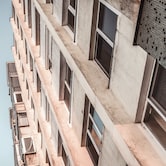
Indoor air dispersion modeling creates a simulation of the flow field, thus predicting where aerosol particles travel in the room and ultimately the surfaces upon which they will be deposited.
Disbursement of Aerosol Particles Containing COVID-19
Research is ongoing into the ability of the COVID-19 virus to last on surfaces and how long the virus can stay in the air in the form of aerosol particles. Initial results indicate that the virus can live for more than a day on surfaces, and remain in the air for up to three hours. More information is available from the Harvard University medical school.
When those infected with the COVID-19 virus cough or sneeze, aerosol particles are expelled. The aerosol particles are formed of fluids containing the virus and cling to dust or moisture in the air. These particles float in the air for up to three hours before settling on a surface where they can live for more than a day.
We must ask, how do we know where these aerosol particles travel whilst airborne, and where do they land? Fortunately, there are established methods for dispersion modelling that allow the trajectory of airborne particles to be tracked.

Particle Counters & the COVID-19 Pandemic: Revolutionizing Design Through Advanced Simulation
“Our objective in working with AGS Consulting was to predict particle motion within the particle counter itself, facilitating optimization of the particle counter geometry. Our experience is that better design minimizes recirculation of particles within the particle counter, irrespective
of particle size.”
Adam Giandomenico, President, Particles Plus
Tracking Aerosol Particles with CFD
A computational fluid dynamic (CFD) model of a room may be created, including any air supply duct, air return duct or in-room fan. The resulting room flow-field is predicted, following which particles may be introduced and their trajectory predicted. Fluid-particle interaction may also be modeled and particle deposition predicted.
Hence, for any given room we may model the flow-field within the room and then predict where aerosol particles containing the COVID-19 virus will travel and the surfaces onto which they will be deposited. The computational methods used to track trajectory and deposition have a history of success, tracking pollutants trajectory and concentration. Hence, established and proven computational tools exist and can be applied to predict where the COVID-19 virus will travel in any room under different ventilation scenarios.
Dispersion modeling of aerosol particles containing COVID-19 can provide those tasked with keeping buildings safe with real insight into how the virus moves around a room, or though a series of rooms. Deposition modelling may augment this by identifying those surfaces onto which the virus will settle. In this new normal, these are invaluable tools for tracking an invisible enemy.

